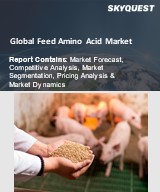
Product ID: SQMIG15E2437

Report ID:
SQMIG15E2437 |
Region:
Global |
Published Date: February, 2024
Pages:
247
|
Tables:
67 |
Figures:
75
The Asia-Pacific region would account for the highest market size in the feed amino acid industry in the year 2021 and will continue to dominate the sector during the forecast period, followed by North America. The rapid rate of industrialization and urbanization in the Asia Pacific has contributed to an increase in the per capita income of the people living in that region. This rise in the level of people's disposable income has contributed to an increase in the demand for food that is high in protein. When comparing the number of feed mills in 2020 to that of 2021, there was approximately a 39%, 18%, and 13% reduction in the number of feed mills in countries such as India, South Korea, and Vietnam, respectively. This trend was particularly noticeable in 2021. Europe is the second-largest compound feed producer globally, with Germany and France being the major producing countries. Poultry feed accounts for a major share of the region’s compound feed market, representing approximately one-third of the total compound feed market.
Despite the persistent rise in the amount of animal protein that is consumed, there has been a consolidation in the agricultural sector, which includes the production of feed. This decline in the number of feed mills reflects this consolidation. The market for feed amino acids in the region is driven by this factor.
Our industry expert will work with you to provide you with customized data in a short amount of time.
REQUEST FREE CUSTOMIZATIONWant to customize this report? This report can be personalized according to your needs. Our analysts and industry experts will work directly with you to understand your requirements and provide you with customized data in a short amount of time. We offer $1000 worth of FREE customization at the time of purchase.

Product ID: SQMIG15E2437